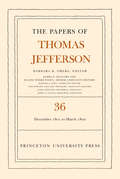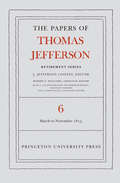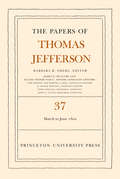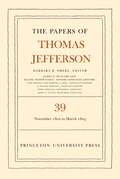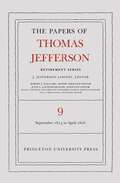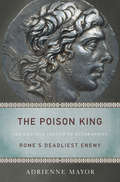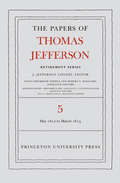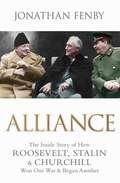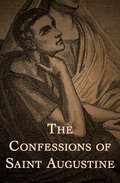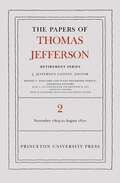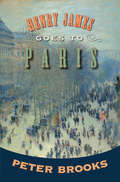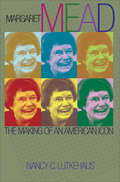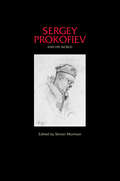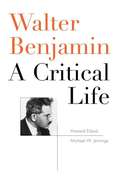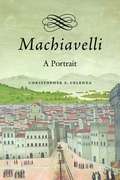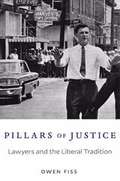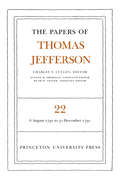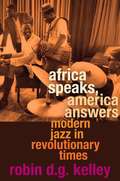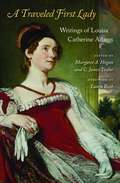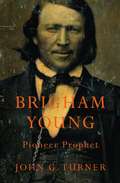- Table View
- List View
The Papers of Thomas Jefferson, Volume 36: 1 December 1801 to 3 March 1802 (Papers of Thomas Jefferson #36)
by Thomas Jefferson Barbara ObergThe period covered by this volume brings to a conclusion Thomas Jefferson's first year as president. On 8 December he communicates his first annual message to Congress: peace between France and England is restored; a rise in population will increase revenue and help abolish internal taxes; the standing army can be done away with; "peace & friendship" prevail with Indian neighbors. He recommends two particular matters to the attention of Congress: a revision of the laws on naturalization and a review of the Judiciary Act. Two delegations of Indian nations hold conferences with Jefferson and Secretary of War Henry Dearborn in Washington. Jefferson observes that it is good for them to "renew the chain of affection." The president receives a "Mammoth Cheese" as a token of esteem from the citizens of Cheshire, Massachusetts, and the letter from the Danbury Baptists arrives. In his famous reply to the Baptists, Jefferson states that "religion is a matter which lies solely between man & his god." Shortly after legislators arrive in town for the opening of Congress, he begins to entertain at the President's House. He uses such occasions to bridge the divide between the executive and legislative branches and foster political understanding between Republicans and Federalists. As he moves into his second year as president, he is optimistic about his legislative program and the Republican majority in Congress.
The Papers of Thomas Jefferson, Retirement Series, Volume 6: 11 March to 27 November 1813 (Papers of Thomas Jefferson, Retirement Series #6)
by Thomas Jefferson J. LooneyVolume Six of the definitive edition of Thomas Jefferson's papers from the end of his presidency until his death presents 516 documents from 11 March to 27 November 1813. Although free from the cares of government, Jefferson cannot disassociate himself from politics entirely. He recommends to President James Madison during the War of 1812 that gunboats be used to protect the Chesapeake Bay, and writes to his congressional son-in-law, John Wayles Eppes, urging the repayment of the national debt and the reining in of the American banking system. Jefferson remains active and healthy, making trips to his beloved Poplar Forest estate, entertaining visitors at Monticello, and happily supervising the education of his grandchildren and other relations. His correspondence shows no signs of abating--he writes to John Waldo and John Wilson to discuss the improvement of English orthography, addresses Isaac McPherson as part of a plea for limits on government-sanctioned intellectual-property rights, and provides a study of Meriwether Lewis for Nicholas Biddle's History of the Expedition under the command of Captains Lewis and Clark. Finally, this volume records the most intense period of correspondence between Jefferson and John Adams during their retirement. In an exchange of thirty-one letters, the two men reveal their hopes and fears for the nation.
The Papers of Thomas Jefferson, Volume 37: 4 March to 30 June 1802 (Papers of Thomas Jefferson #37)
by Thomas Jefferson Barbara ObergThis volume opens on 4 March 1802, the first anniversary of Thomas Jefferson's inauguration as the nation's third president, and closes on 30 June. In March, a delegation of Seneca Indians comes to Washington to discuss their tribe's concerns, and Jefferson names a commissioner to handle a land sale by Oneida Indians to the state of New York. In April, the Senate ratifies a treaty with the Choctaw nation for a wagon road across their lands. Jefferson worries about an increasingly dictatorial France taking back control of New Orleans, prompting him to the intemperate remark that he would "marry" America's fortunes to the British fleet. Charles Willson Peale sends him sketches of the skull of a prehistoric bison found in Kentucky. During the closing, and very frustrating, weeks of Congress, he distracts himself with a cipher devised by Robert Patterson. He prepares lists of books to be purchased for the recently established Library of Congress and also obtains many titles for his own collection. Even while he is in Washington occupied with matters of state, Jefferson has been keeping close watch on the renovations at Monticello. In May, he has Antonio Giannini plant several varieties of grapes in the southwest vineyard, and he orders groceries, molasses, dry Lisbon wine, and cider to be shipped to Monticello in time for his arrival. He looks forward "with impatience" to the moment he can embrace his family once more.
The Papers of Thomas Jefferson, Volume 39: 13 November 1802 to 3 March 1803 (Papers of Thomas Jefferson #39)
by Thomas Jefferson Barbara ObergThis volume opens on 13 November 1802, when Jefferson is in Washington, and closes on 3 March 1803, the final day of his second year as president. The central issue of these months is the closing of the right of deposit at New Orleans, an act that threatens the economic wellbeing of Westerners. Jefferson asks his old friend Pierre Samuel du Pont de Nemours to remind the French government of the strong friendship between the two nations. To disarm the political opposition, the president sends James Monroe, who is respected by the Federalists, to Europe as a special envoy to work with Robert Livingston in negotiating the dispute with France. Jefferson proposes a "bargain" that will result in the acquisition of the Louisiana Territory. In a confidential message to Congress, Jefferson seeks $2,500 to send a small party of men to explore the Missouri River. Congress concurs, and Jefferson's secretary Meriwether Lewis will lead the expedition. Settling the boundaries with Native American lands is a major theme of the volume. In reality, "settling" results in major cessions of Indian lands to the American government. During the months of this volume Jefferson never leaves the capital, even for a brief sojourn at Monticello. He does, however, enjoy a visit of six weeks from his daughters and two of his grandchildren. They participate in Washington society, capture the affection of Margaret Bayard Smith, and brighten Jefferson's days.
The Papers of Thomas Jefferson, Retirement Series, Volume 9: 1 September 1815 to 30 April 1816 (Papers of Thomas Jefferson, Retirement Series #9)
by Thomas Jefferson J. LooneyVolume Nine of the project documenting Thomas Jefferson's last years presents 523 documents from 1 September 1815 to 30 April 1816. In this period, Jefferson makes three trips to Poplar Forest. During two visits to the Peaks of Otter, he measures their altitude and his calculations are reprinted in several newspapers. Jefferson welcomes the returning war hero Andrew Jackson in a visit to Poplar Forest and offers a toast at a public dinner in Lynchburg held in the general's honor. With the end of the War of 1812, Jefferson uses European contacts to begin restocking his wine cellar and refilling his bookshelves. In a draft letter to Horatio G. Spafford, Jefferson indulges in a "tirade" against a pamphlet by a New England clergyman. Jefferson decides to drop the section from the letter but sends it to Richmond Enquirer publisher Thomas Ritchie with permission to publish it without Jefferson's name. An anonymous letter in the Washington Daily National Intelligencer on the interpretation of the U.S. Constitution elicits a similarly anonymous response from Jefferson. His family circle grows with the birth of a great-granddaughter. Despite a report of his death, Jefferson continues to enjoy perfect health.
The Red Notebook and other writings (PDF)
by Paul AusterA collection of interviews and essays in which the American writer Paul Auster reflects on the need to break down the boundary between living and writing, and on the use of certain genre conventions to penetrate matters of memory and identity.
The Poison King: The Life and Legend of Mithradates, Rome's Deadliest Enemy
by Adrienne MayorMachiavelli praised his military genius. European royalty sought out his secret elixir against poison. His life inspired Mozart's first opera, while for centuries poets and playwrights recited bloody, romantic tales of his victories, defeats, intrigues, concubines, and mysterious death. But until now no modern historian has recounted the full story of Mithradates, the ruthless king and visionary rebel who challenged the power of Rome in the first century BC. In this richly illustrated book--the first biography of Mithradates in fifty years--Adrienne Mayor combines a storyteller's gifts with the most recent archaeological and scientific discoveries to tell the tale of Mithradates as it has never been told before.The Poison King describes a life brimming with spectacle and excitement. Claiming Alexander the Great and Darius of Persia as ancestors, Mithradates inherited a wealthy Black Sea kingdom at age fourteen after his mother poisoned his father. He fled into exile and returned in triumph to become a ruler of superb intelligence and fierce ambition. Hailed as a savior by his followers and feared as a second Hannibal by his enemies, he envisioned a grand Eastern empire to rival Rome. After massacring eighty thousand Roman citizens in 88 BC, he seized Greece and modern-day Turkey. Fighting some of the most spectacular battles in ancient history, he dragged Rome into a long round of wars and threatened to invade Italy itself. His uncanny ability to elude capture and surge back after devastating losses unnerved the Romans, while his mastery of poisons allowed him to foil assassination attempts and eliminate rivals.The Poison King is a gripping account of one of Rome's most relentless but least understood foes.
The Papers of Thomas Jefferson, Retirement Series, Volume 5: 1 May 1812 to 10 March 1813 (Papers of Thomas Jefferson, Retirement Series #5)
by Thomas Jefferson J. LooneyVolume Five of the definitive edition of Thomas Jefferson's papers from the end of his presidency until his death includes 592 documents from 1 May 1812 to 10 March 1813. America declares war on Great Britain on 18 June 1812. Jefferson counsels domestic reconciliation while suggesting that America recruit British incendiaries to burn London if British ships attack American cities. He passes on to President James Madison a long and discouraging letter from Isaac A. Coles describing American military bungling in the Niagara Campaign. An unofficial proposal that Jefferson return to public life as secretary of state does not gain the retired statesman's support. Jefferson receives many requests for governmental patronage, responds insightfully to a colorful assortment of authors and inventors, is mildly diverted by a fraudulent perpetual-motion machine, and spends considerable time on legal troubles. A dispute with David Michie over land in Albemarle County nearly leads to a duel between Michie and Jefferson's agent. A conflict with Samuel Scott over property in Campbell County further vexes Jefferson, who prepares an extensively researched answer to Scott's complaint. Despite the conflict, Jefferson graciously writes a letter of introduction for Scott's son. Jefferson remains accessible to the public, receives anonymous letters urging him to convert to Christianity, and settles a wager for one correspondent who asks if Jefferson ever met the British king. Jefferson gloomily observes that "the hand of age is upon me" and complains that his faculties are failing. He still has thirteen years to live.
Alliance: The Inside Story Of How Roosevelt, Stalin And Churchill Won One War And Began Another
by Jonathan FenbyThe history of the Second World War is usually told through its decisive battles and campaigns. But behind the front lines, behind even the command centres of Allied generals and military planners, a different level of strategic thinking was going on. Throughout the war the 'Big Three' -- Churchill, Roosevelt and Stalin -- met in various permutations and locations to thrash out ways to defeat Nazi Germany -- and, just as importantly, to decide the way Europe would look after the war. This was the political rather than military struggle: a battle of wills and diplomacy between three men with vastly differing backgrounds, characters -- and agendas. Focusing on the riveting interplay between these three extraordinary personalities, Jonathan Fenby re-creates the major Allied conferences including Casablanca, Potsdam and Yalta to show exactly who bullied whom, who was really in control, and how the key decisions were taken. With his customary flair for narrative, character and telling detail, Fenby's account reveals what really went on in those smoke-filled rooms and shows how "jaw-jaw" as well as "war-war" led to Hitler's defeat and the shape of the post-war world.
The Confessions of Saint Augustine
by Saint AugustineThe world’s most famous spiritual autobiography Written between 397 and 398 CE, The Confessions of Saint Augustine is the story of Augustine of Hippo’s childhood in Numidia, his youth and early adulthood in Carthage, Rome, and Milan, and his conversion to Christianity. As he struggled to liberate himself from his sinful past, Augustine embarked on a quest that would transform him into one of the most influential religious thinkers of all time. A moving testament to the power of faith and an inspirational guide to a fulfilled life, The Confessions of Saint Augustine is a masterwork of Western literature. This ebook has been professionally proofread to ensure accuracy and readability on all devices.
The Papers of Thomas Jefferson, Retirement Series, Volume 2: 16 November 1809 to 11 August 1810 (Papers of Thomas Jefferson, Retirement Series #2)
by Thomas Jefferson J. LooneyThe definitive edition of Thomas Jefferson's papers from the end of his presidency until his death continues with Volume Two, which covers the period from 16 November 1809 to 11 August 1810. Both incoming and outgoing letters are included, totaling 518 documents printed in full. General themes include Jefferson's financial troubles, which eventually led him to loan himself a large sum of money he was managing for Tadeusz Kosciuszko; his preparations to face a lawsuit stemming from his decision as president to remove Edward Livingston from a valuable property in New Orleans; other legal complications involving his landholdings and the settlement of estates he had inherited long before; his plans to breed merino sheep and share them gratis with his fellow Virginians; and his ongoing interest in the Republican party's success. Highlights include a long list of books on agriculture that Jefferson probably compiled to guide the Library of Congress in its purchases; descriptions of inventions by Robert Fulton and more obscure figures such as the New Orleans engineer Godefroi Du Jareau; Jefferson's draft letter criticizing the Quakers as unpatriotic, much of which he later deleted; the letter in which he ordered a set of silver tumblers that have become known as the Jefferson Cups; and an important treatise on taxation by the distinguished French political economist Pierre Samuel Du Pont de Nemours, published here for the first time.
Henry James Goes to Paris
by Peter BrooksHenry James's reputation as The Master is so familiar that it's hard to imagine he was ever someone on whom some things really were lost. This is the story of the year--1875 to 1876--when the young novelist moved to Paris, drawn by his literary idols living at the center of the early modern movement in art. As Peter Brooks skillfully recounts, James largely failed to appreciate or even understand the new artistic developments teeming around him during his Paris sojourn. But living in England twenty years later, he would recall the aesthetic lessons of Paris, and his memories of the radical perspectives opened up by French novelists and painters would help transform James into the writer of his adventurous later fiction. A narrative that combines biography and criticism and uses James's writings to tell the story from his point of view, Henry James Goes to Paris vividly brings to life the young American artist's Paris year--and its momentous artistic and personal consequences. James's Paris story is one of enchantment and disenchantment. He initially loved Paris, he succeeded in meeting all the writers he admired (Turgenev, Flaubert, Zola, Maupassant, Goncourt, and Daudet), and he witnessed the latest development in French painting, Impressionism. But James largely found the writers disappointing, and he completely misunderstood the paintings he saw. He also seems to have fallen in and out of love in a more ordinary sense--with a young Russian aesthete, Paul Zhukovsky. Disillusioned, James soon retreated to England--for good. But James would eventually be changed forever by his memories of Paris.
Margaret Mead: The Making of an American Icon
by Nancy Lutkehaus"Never doubt that a small group of thoughtful, committed citizens can change the world."--Margaret Mead This quotation--found on posters and bumper stickers, and adopted as the motto for hundreds of organizations worldwide--speaks to the global influence and legacy of the American anthropologist Margaret Mead (1901-78). In this insightful and revealing book, Nancy Lutkehaus explains how and why Mead became the best-known anthropologist and female public intellectual in twentieth-century America. Using photographs, films, television appearances, and materials from newspapers, magazines, and scholarly journals, Lutkehaus explores the ways in which Mead became an American cultural heroine. Identifying four key images associated with her--the New Woman, the Anthropologist/Adventurer, the Scientist, and the Public Intellectual--Lutkehaus examines the various meanings that different segments of American society assigned to Mead throughout her lengthy career as a public figure. The author shows that Mead came to represent a new set of values and ideas--about women, non-Western peoples, culture, and America's role in the twentieth century--that have significantly transformed society and become generally accepted today. Lutkehaus also considers why there has been no other anthropologist since Mead to become as famous. Margaret Mead is an engaging look at how one woman's life and accomplishments resonated with the issues that shaped American society and changed her into a celebrity and cultural icon.
Sergey Prokofiev and His World (The\bard Music Festival Ser.)
by Simon MorrisonSergey Prokofiev (1891-1953), arguably the most popular composer of the twentieth century, led a life of triumph and tragedy. The story of his prodigious childhood in tsarist Russia, maturation in the West, and rise and fall as a Stalinist-era composer is filled with unresolved questions. Sergey Prokofiev and His World probes beneath the surface of his career and contextualizes his contributions to music on both sides of the nascent Cold War divide. The book contains previously unknown documents from the Russian State Archive of Literature and Art in Moscow and the Prokofiev Estate in Paris. The literary notebook of the composer's mother, Mariya Grigoryevna, illuminates her involvement in his education and is translated in full, as are ninety-eight letters between the composer and his business partner, Levon Atovmyan. The collection also includes a translation of Sigizmund Krzhizhanovsky's unperformed stage adaptation of Eugene Onegin, for which Prokofiev composed incidental music in 1936. The essays in the book range in focus from musical sketches to Kremlin decrees. The contributors explore Prokofiev's time in America; evaluate his working methods in the mid-1930s; document the creation of his score for the film Lieutenant Kizhe; tackle how and why Prokofiev rewrote his 1930 Fourth Symphony in 1947; detail his immortalization by Soviet bureaucrats, composers, and scholars; and examine Prokofiev's interest in Christian Science and the paths it opened for his music. The contributors are Mark Aranovsky, Kevin Bartig, Elizabeth Bergman, Leon Botstein, Pamela Davidson, Caryl Emerson, Marina Frolova-Walker, Nelly Kravetz, Leonid Maximenkov, Stephen Press, and Peter Schmelz.
Stephen Crane: A Life Of Fire
by Paul SorrentinoStephen Crane's short, compact life--"a life of fire," he called it--is surrounded by myths, distortions, and fabrications. Paul Sorrentino has sifted through garbled chronologies and contradictory eyewitness accounts, scoured the archives, and followed in Crane's footsteps. The result is the most accurate account of the poet and novelist to date.
Admiral Bill Halsey: A Naval Life
by Thomas Alexander HughesWilliam Halsey, the most famous naval officer of World War II, was known for fearlessness, steely resolve, and impulsive errors. In this definitive biography, Thomas Hughes punctures the popular caricature of the fighting admiral to present a revealing human portrait of his personal and professional life as it was lived in times of war and peace.
Walter Benjamin: A Critical Life
by Howard EilandWalter Benjamin was perhaps the twentieth century's most elusive intellectual. His writings defy categorization, and his improvised existence has proven irresistible to mythologizers. In a major new biography, Howard Eiland and Michael Jennings present a comprehensive portrait of the man and his times, as well as extensive commentary on his work.
Machiavelli: A Portrait
by Christopher CelenzaThe man whose name is shorthand for all that is ugly in politics was more nuanced than his reputation suggests. Christopher Celenza’s portrait of Machiavelli removes the varnish to reveal not just the hardnosed philosopher but the skilled diplomat, learned commentator on ancient history, comic playwright, tireless letter writer, and thwarted lover.
Pillars of Justice: Lawyers and the Liberal Tradition
by Owen FissThe constitutional theorist Owen Fiss explores the purpose and possibilities of life in the law through a moving account of thirteen lawyers who shaped the legal world during the past half century. He tries to identify the unique qualities of mind and character that made these individuals so important to the institutions and principles they served.
The Papers of Thomas Jefferson, Volume 22: 6 August-31 December 1791 (Papers Of Thomas Jefferson Ser. #22)
by Thomas Jefferson Charles CullenThe months covered by this volume illustrate the variety of topics characteristic of the Jefferson Papers. Subjects range from Jefferson's continued overseeing of the planning of the Federal District that became Washington, D.C., to his worries over his debts and his exchange of correspondence with the free black Benjamin Banneker. This period, an unusually significant time for Jefferson as Secretary of State, saw the opening of a new phase of diplomacy. When Jefferson returned to the capital after a stay at Monticello in the fall, the first British minister to the United States had arrived, and the new representative from France had been in the city since August.During this time Jefferson began keeping private notes on important political conversations, notes that he later collected and bound. These notes were published after his death as Jefferson's Anas, a work never closely examined until now and often extended beyond Jefferson's evident intention. Ascertaining that Jefferson collected and intended only those documents from his tenure as Secretary of State to be used to challenge the Federalist interpretation of Washington's administration, the present editors publish the Anas notes not as compiled late in Jefferson's life or as amplified by others, but in chronological order, in the context in which they were written. Also discovered during the preparation of this volume was a new, later date or that portion of Jefferson's famous Espistolary Record written in his own hand.
Africa Speaks, America Answers: Modern Jazz in Revolutionary Times (The Nathan I. Huggins lectures #13)
by Robin D. KelleyThis collective biography of four jazz musicians from Brooklyn, Ghana, and South Africa demonstrates how modern Africa reshaped jazz, how modern jazz helped form a new African identity, and how musical convergences and crossings altered the politics and culture of both continents.
Josephine Baker and the Rainbow Tribe
by Matthew Pratt GuterlHer performing days numbered, Josephine Baker did something outrageous: she transformed her chateau into a theme park whose main attraction was her Rainbow Tribe--12 children from around the globe, adopted as the family of the future. Matthew Pratt Guterl concludes that Baker was a serious activist, determined to make a positive difference.
A Traveled First Lady: Writings Of Louisa Catherine Adams
by Louisa Catherine AdamsLouisa Catherine Adams was daughter-in-law and wife of presidents, assisted diplomat J. Q. Adams at three European capitals, and served as a D.C. hostess for three decades. Yet she is barely remembered today. A Traveled First Lady (with Foreword by Laura Bush) corrects this oversight, by sharing Adams's remarkable story in her own words.
Brigham Young: Pioneer Prophet
by John G. TurnerBrigham Young was a rough-hewn New York craftsman whose impoverished life was electrified by the Mormon faith. Turner provides a fully realized portrait of this spiritual prophet, viewed by followers as a protector and by opponents as a heretic. His pioneering faith made a deep imprint on tens of thousands of lives in the American Mountain West.
Walter Lippmann: Public Economist
by Craufurd D. GoodwinUnemployment, monetary and fiscal policy, and the merits and drawbacks of free markets were a few of the issues the journalist and public philosopher Walter Lippmann explained to the public during the Depression, when professional economists skilled at translating concepts for a lay audience were not yet on the scene, as Craufurd Goodwin shows.
